Archive for the 'National cinemas: New Zealand' Category
Kia ora from New Zealand
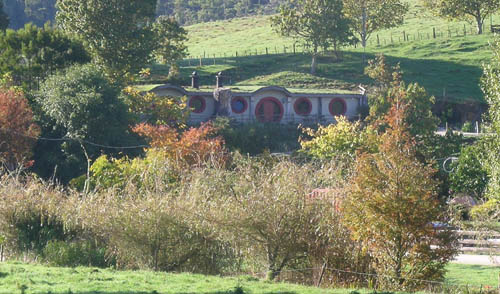
KT here:
David and I have been fairly busy during our first week and a half as Hood Fellows at the University of Auckland. Our hosts have kindly scheduled all our talks for early on in our stay, leaving time to see the attractions of Auckland and its surroundings.
This past Sunday we took a tour of some of the Waitomo Caves, famous primarily for caverns in which thousands of glowworms light up the ceiling like so many stars. It’s quite a long ride by bus to reach the area. This happens to be the off-season for tourists in New Zealand, May being the equivalent of the Northern Hemisphere’s November. So far, however, we’ve actually experienced a streak of unseasonably warm, sunny weather.
We happened to be the only passengers on the bus going down to Waitomo, though there we joined a group totaling seven for the actual cave tour. On the way, we initially saw lots of fog and then spectacular mountains and valleys. That part of New Zealand is largely devoted to dairy farms, so we saw many bucolic landscapes full of cows.
Our driver, Pete, regaled us with many stories, including how a group of tourists had dubbed his bus (then brand new) Tillie. Pete hadn’t recognized the connection to the old Walter Matthau-Carol Burnett movie Pete ‘n’ Tillie, but he liked the name and has used it ever since.
As we neared Waitomo, Pete took us off the main route onto a more scenic road. As we drove, he pointed out Woodlyn Park, a motel with themed rooms, including two “hobbit holes.” These look fairly similar to the facades used in The Lord of the Rings, except that the two fronts are joined at the middle, like a Middle-earth duplex, or as the British say, semi-detached. The furniture inside apparently is people-sized rather than appropriate for hobbits. The photos on the motel’s website look somewhat incongruous, with their modern stove and sink, but the beautiful surroundings suggest that for a fan doing an independent driving tour through New Zealand, this would be a pleasant place to spend the night.
I had been aware of Woodlyn Park from the period when I was scanning for internet for LOTR-related products for The Frodo Franchise. I had never particularly taken note of where it was, so this unexpected chance to see it, if only from the road, seemed like a fortuitous coincidence.
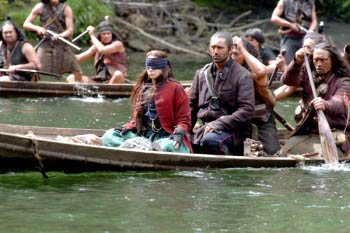
In my previous entry, I mentioned that Māori TV is running a series of classic New Zealand films on Sunday nights. We got back from our Waitomo trip just in time to catch Vincent Ward’s first feature, Vigil (1984). It’s an impressive debut, with brooding images of harsh landscapes punctuated by startling cries of birds. The result looks like a blend of Bergman and Tarkovsky.
The film deals with a girl living with her parents on a struggling sheep farm and her efforts to understand the baffling events happening around her without much guidance. Her father is killed trying to retrieve a lost sheep, and her mother, embittered by her lost dreams of becoming a ballerina, tries to force her tomboy daughter to start practicing in the hope that they soon can leave the farm behind. Into all this wanders a vaguely threatening poacher who may or may not have illicit designs on the heroine.
Told largely from the girl’s point of view, the result is a grim but fascinating study in character and mood. It’s a pity that Vigil is not currently available on DVD, though used copies with various region codings are knocking around the internet.
By the way, I managed to see Ward’s most recent film, River Queen (above), at the American Film Market in 2005. Apart from in New Zealand, the film has had virtually no distribution, apparently going direct to DVD in some countries. (It’s currently available from German Amazon and on pre-order status at French Amazon.)
Again, it’s a pity, because although it’s not a masterpiece, it’s an entertaining and engaging period adventure involving a woman who goes into the New Zealand wilderness to rescue her kidnapped son. It is done on an epic scale that deserve to be seen on the big screen. Rumors of various problems that plagued and prolonged the filming have given River Queen an undeservedly bad reputation. Apart from a bit of choppy exposition at the beginning, I saw few signs of the fact that Ward had not been able to finish all the planned footage.
Samantha Morton’s illness (and rumored clashes with Ward) delayed the film, but she gives an intense and convincing performance. So does Cliff Curtis, an excellent Māori actor (The Piano, Once Were Warriors, and Whale Rider) who has also turned into an all-purpose ethnic player, cropping up in a wide variety of roles—often Arabs—in such films as Three Kings, The Insider, and the current Sunshine.
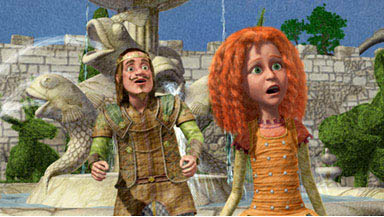
I also mentioned that Jane and the Dragon, a children’s television series co-produced by Weta Workshop, was premiering here on May 19. Upon further research, I discovered that the series played in Canada and Australia way back in October of 2005. It premiered on September 9, 2006, on NBC in the US. (I don’t follow children’s television, so I had missed watching it then.)
The series is one of several in the Qubo agreement, whereby NBC and other companies pledge to promote quality children’s television. Perhaps this constitutes an admission that that’s not what we’ve been getting up to now.
The first episode of Jane and the Dragon was charming, though it definitely was aimed at small children. The original book has been reissued as a tie-in to the series, and the Amazon description lists it as suitable for ages 4 to 8.
For me the series’ main interest lies in the innovative technique Weta Workshop has developed to aid in the CGI. When I first interviewed Richard Taylor, head of the Workshop, back in October, 2003, he emphasized that his company depended very little on digital technology. In contrast, the other half of Weta Ltd., Weta Digital, is entirely computer-based, providing the cutting-edge CGI not only for The Lord of the Rings but also King Kong and sequences in I, Robot, X-Men 3: The Last Stand, Eregon and others. By our second discussion, in December, 2004, Weta Workshop was moving more toward digital technology. A new motion-capture studio was just beginning to be tested. No doubt the Workshop’s designers will continue to emphasize real props, maquettes, prosthetics, and similar objects, but it has branched out.
The result in Jane is a world that resembles a series of detailed colored-pencil illustrations from a children’s book. The world is three-dimensional, however, with the characters created in sophisticated motion capture and the “camera” gliding freely through the “drawn” space. The effect is a little disconcerting at first, with the characters in lively motion and the backgrounds utterly still. Once one gets used to the contrast, however, the effect is pleasant and technically very impressive. Despite the use of motion capture, the characters are stylized rather than realistic, like detailed cel animation but in 3D.
Tomorrow I am scheduled to take the ominously named “Mordor & Mt. Doom Express.” This is a lengthy drive out from Auckland to the area around Mt. Ruhapehu, where Frodo and Sam struggled up the mountain to destroy the Ring (when they were not doing the same thing against blue and green screens in the studio). The point is not just to visit the movie locations from The Lord of the Rings, though. Naturally the filmmakers chose some of the most dramatic scenery in the country to embody Middle-earth—places a tourist would want to visit quite apart from their appearance in the movie.
Then on Sunday I’m headed for a brief stay in Wellington, where I spent many exciting weeks doing the interviews and facilities tours that constituted much of the research for The Frodo Franchise. I hope to be able to report from there in my next entry.
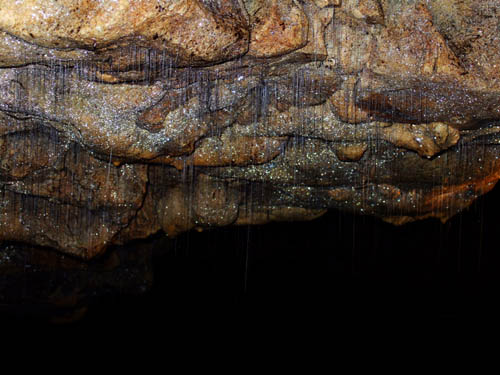
Glowworms show up as tiny green lights. They spin single strands that hang below them and catch small insects drawn into the cave by air currents.
Dispatch from the Land of the Long White Cloud
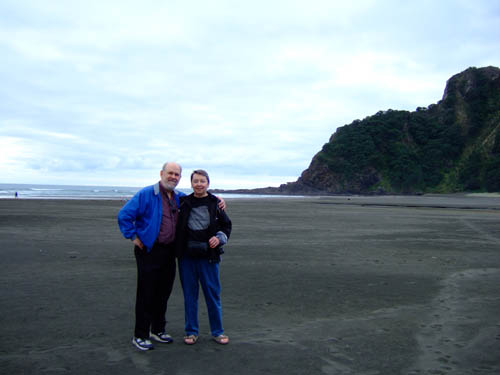
Kristin here—
David and I are currently in New Zealand. The University of Auckland offered us both Hood Fellowships, and we will be in residence here for the month of May.
After settling into a hotel room with a splendid view of part of the Auckland harbor and downtown, we were shown around the campus by our host, Brian Boyd, Nabokov scholar extraordinaire. We’ll be giving lectures in classes and to the public over the next week and a half. I’ll also be doing some media interviews relating to The Frodo Franchise, which is due to be published here by Penguin New Zealand, probably in early September. Today, in fact, I met my editors and publicity person at Penguin.
Yesterday Brian and his wife Bronwen Nicholson drove us out to the Waitakere Ranges Regional Park, a large area on the coast west of Auckland. The park is spectacularly beautiful in itself, but our goal was Karekare Beach, one of several black-sand beaches within the park. It was the location where the beach scenes of Jane Campion’s The Piano were shot and even now remains a popular tourist destination. There we are (above), more or less at the spot where Holly Hunter’s character brought her piano ashore in her new home.
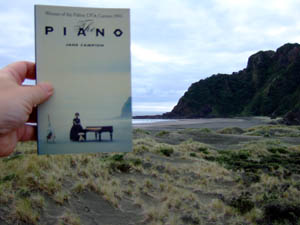
Naturally we have also done some book and DVD shopping. When I first came to New Zealand to work on The Frodo Franchise, back in September and October of 2003, there were almost no Kiwi films on DVD: Once Were Warriors, of course, and Whale Rider, the two most popular New Zealand features, and a few others.
As I discuss in the book (Chapter 10), The Lord of the Rings had a beneficial impact on New Zealand cinema. In large part because of the trilogy, filmmakers gained new skills, new production infrastructure was created, local directors and other talent returned from jobs abroad, and government funding increased. Kiwi films became more popular within their own country. When I talked to Dr. Ruth Harley, CEO of the New Zealand Film Commission, in late 2005, she declared that the national cinema was perhaps having its best year ever, and the momentum does not seem to have slowed.
One sign of success is that one can now find some of the older classics on DVD. There’s actually a “Roger Donaldson Collection” series. (That’s the same Roger Donaldson who is more famous in U.S. for The Bounty, Dante’s Peak, and Cocktail.) We picked up his Sleeping Dogs (1977), notable as the first New Zealand film to play in American theaters, and Smash Palace (1981), the movie that led to his career abroad. A DVD set from this series containing both films is available in the U.S.
I saw Donaldson’s latest, The World’s Fastest Indian (2005) at the American Film Market in 2005—the same occasion upon which I interviewed Dr. Harley for the second time for my book. I opined to her that the film might well be a considerable success in the US. It’s an engaging and entertaining film with Anthony Hopkins giving a marvelous performance in the true story of an eccentric Kiwi who tinkered with an old motorcycle (the “Indian” of the title) and set a world speed record with it.
Unfortunately The World’s Fastest Indian was released without much publicity and didn’t do much business in the US. It’s well worth seeking out on DVD.
There are other signs of increased interest in local films. Geoff Murphy’s hit film Goodbye Pork Pie (1981), previously available on a PAL DVD without region coding, has come out in a “Special Collector’s Edition” with a new transfer, a stereo soundtrack not included on the original release prints, and a second disc of extras. Three years ago I would not have predicted that an older Kiwi film would get such treatment. Murphy is better known in the art-cinema world for his later Utu (1983) and The Quiet Earth (1985).
Similarly, May 6 saw the inauguration of a series of eight older Kiwi films to be shown weekly on Sunday nights until June 24 on Māori Television, one of the national channels in New Zealand. Most of these are not specifically oriented toward Māori subject matter—perhaps further indication that a curiosity about Kiwi cinema in general has spread through the national culture. The opening film, The Last Tattoo (1994), was an engrossing political thriller set in 1943. I look forward to seeing as many of the others in the series as time permits.
Recent DVDs have also allowed me to catch up with two 2006 New Zealand films that I had not had a chance to see yet. Both received favorable reviews from Variety when they played at North American film festivals.
Sione’s Wedding is set among the Samoan community of Auckland. It follows four irresponsible young men as they try to fulfill a condition that will allow them to attend the wedding: they must all find “real” dates to bring along. No. 2 deals with an extended family struggling to organize a traditional Fijian feast on short notice when the matriarch declares that she will name her successor at the event.
Both are made with the sorts of technical resources that one would expect of an American indie film. New Zealand films still work with small budgets, but funding is distinctly larger than in the pre-Lord of the Rings era. Strikingly, both of these films deal with the familiar situation of a big family event where irresponsible men must be led to maturity by their women. Both are also highly enjoyable, especially No. 2, with its skillful blend of humor and sentiment and its powerful performance by Ruby Dee as the matriarch.
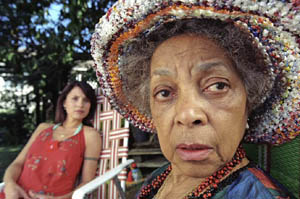
Sione’s Wedding, retitled Samoan Wedding for the North American release, received an enthusiastic review from Variety after its premiere at the Montreal World Film Festival late last summer. Magnolia released it on November 10, 2006, with a run of 14 weeks. It started in two theaters, with a respectable $7,852 average on its opening weekend. Eventually it played in only three theaters, made $72,244, and disappeared. It did, however, come out on DVD.
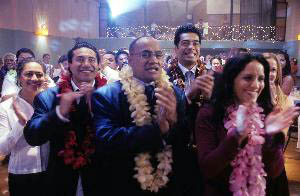
No. 2, also well-reviewed by Variety, is apparently to be released in the U.S. under the title Naming Number Two. For those living in or near New York, it will be shown on May 10 as part of the Pacifika Showcase series.
By a happy coincidence, next Saturday on TV2 at 5:30 pm, I’ll be able to watch the premiere of the children’s animated series Jane and the Dragon. Back in October 2003, when I interviewed Richard Taylor, head of Weta Workshop, he mentioned that he was trying to diversify the company’s projects so as to be able to offer steady work to his employees. One project was this series, for which he was then seeking financing.
Just over a year later, in early December 2004, I interviewed Richard again. By another coincidence, that was the day when Weta was beginning to test its new motion-capture studio that had been created to help in the production of Jane and the Dragon and other projects. Now at last the series is finished.
It’s already playing on Canadian TV, and the YTV.com site offers an entire episode for viewing here. The official website, aimed specifically at children, is here.
I hope to report back on it and other media-related experiences here in New Zealand, or Aoteroa, which means “The Land of the Long White Cloud.” It’s a well-deserved name. Anyone who thinks the mountains and other unspoiled landscapes shown in The Lord of the Rings and The Lion, the Witch and the Wardrobe were created by CGI are mistaken. Much of New Zealand actually looks like that. I’m hoping to visit a few of the film locations that I haven’t seen on previous visits.
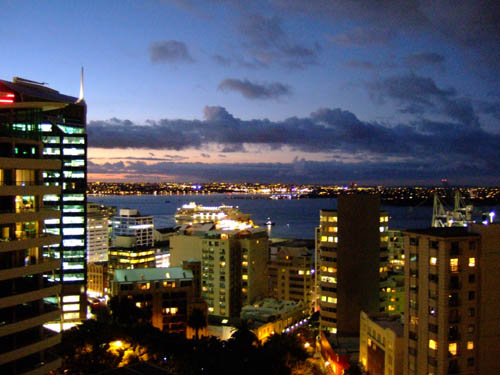
The view from our hotel balcony.













